The covert nature of military operations often leaves the public curious about the strategies and tactics used. One such operation, codenamed Operation Midnight Hammer, revealed the U.S. military’s remarkable skill in planning, coordination, and execution. Designed to disrupt Iran’s nuclear enrichment program, this mission highlights the high-stakes game of international security.
This blog explores the details of Operation Midnight Hammer—from its inception to the impact it left on Iran’s nuclear network. We’ll examine how the operation unfolded, the advanced military technology employed, and its implications for regional stability and nuclear non-proliferation efforts.
Table of Contents
Planning and Execution
Executing a mission as complex as Operation Midnight Hammer required meticulous preparation and flawless coordination. The United States military devised an elaborate plan involving decoy strategies, precision timing, and unprecedented stealth, making this operation a prime example of modern military expertise.
The 18-Hour Round Trip
The operation began under the shroud of midnight on Saturday. Seven B-2 stealth bombers took off from Whiteman Air Force Base in Missouri, embarking on an 18-hour flight each way. To ensure their uninterrupted flight path, the bombers underwent multiple mid-air refuelling sessions — a crucial yet high-risk component of the mission. This refuelling ensured the bombers maintained range while remaining undetected.
Decoys and Deception
One of the operation’s most ingenious tactics was the use of decoy flights. A separate fleet of aircraft flew west over the Pacific Ocean, allegedly heading towards the U.S. territory of Guam. This manoeuvre distracted global attention away from the accurate trajectory of the stealth bombers, which were directed eastward over the Atlantic toward Iran.
General Dan Caine, Chairman of the Joint Chiefs of Staff, described this elaborate deception as a “key strategic element,” ensuring the bombers reached their targets unnoticed.
Key Assets Deployed
Operation Midnight Hammer’s success relied heavily on advanced military assets specifically tailored to handle Iran’s heavily fortified nuclear facilities.
The Unseen Power of the B-2 Stealth Bombers
At the heart of the operation were B-2 Spirit bombers, technologically advanced aircraft known for their stealth capabilities. Designed for penetration of dense anti-aircraft defences, these bombers remain virtually undetectable even when flying close to hostile zones.
Each aircraft carried GBU-57 Massive Ordnance Penetrators (MOPs), also known as “bunker buster” bombs. Capable of penetrating up to 18 meters (60 feet) of reinforced concrete or over 60 meters (200 feet) of solid earth, these bombs were uniquely suited to target deeply buried nuclear sites like Fordo.
Support from the Skies and Seas
To protect and enhance the bombers’ mission, support aircraft swept ahead, scanning for enemy fighters and surface-to-air missile threats. These measures ensured no Iranian defences were triggered.
Meanwhile, Tomahawk cruise missiles were launched from a U.S. submarine stationed in the Arabian Sea. Over two dozen missiles targeted the Isfahan nuclear facility nearly simultaneously with the B-2 bombers’ strikes, showcasing a well-coordinated surprise assault.
Timeline of the Strikes
Coordinated Surprise Attacks
The timeline began at approximately 00:01 EDT with the bombers’ departure from Missouri and culminated 18 hours later with precision strikes in Iran.
- 17:00 EDT (22:00 BST): Tomahawk missiles launched from the Arabian Sea targeted the Isfahan nuclear facility hundreds of kilometres inland.
- 18:40 EDT (23:40 BST): The lead B-2 bomber dropped its payload on Fordo, a nuclear enrichment facility buried deep beneath a mountain. This site had long been central to Iran’s nuclear aspirations.
- Over the next 25 minutes, the bombers deployed 14 MOPs, hitting both the Fordo facility and Natanz, another critical nuclear site. Within this tight timeframe, more than 75 guided weapons struck their designated targets.
By 19:30 EDT (00:30 BST), the bombers exited Iranian airspace unscathed, beginning their return to the United States with the whole operation completed in under 24 hours.
Impact and Assessment
Damage to Iran’s Nuclear Capabilities
The Pentagon declared Operation Midnight Hammer a resounding tactical success, citing the near-total destruction of key nuclear sites. U.S. Secretary of Defense Pete Hegseth hailed it as a “powerful and clear” demonstration of American military strength.
Despite these claims, experts suggest that while the strikes set back Iran’s nuclear program, the extent of the damage remains uncertain. While satellite imagery can show above-ground impacts, it cannot confirm whether MOPs reached critical underground facilities.
Broader Implications
Beyond the operational details, this mission raises questions about its long-term impact on regional stability. While the strikes temporarily halt Iran’s nuclear ambitions, they are unlikely to eliminate them permanently. Indeed, such actions could further inflame tensions in an already volatile region.
Frequently Asked Questions
Why did the U.S. target Iran’s nuclear sites?
The operation aimed to disrupt Iran’s nuclear enrichment program, which the U.S. views as a threat to global security. Targeting facilities like Fordo and Natanz was strategic, as these sites are pivotal to Iran’s nuclear capabilities.
What is a “bunker buster” bomb?
The GBU-57 Massive Ordnance Penetrator (MOP) is a specialized bomb capable of penetrating deep into the earth or reinforced concrete shelters. It was explicitly designed for hardened or deeply buried targets like Iran’s nuclear facilities.
Were any Iranian defences activated during the operation?
According to U.S. officials, Iranian air defences and fighter jets did not engage, likely due to the advanced stealth tactics employed by American bombers and support aircraft.
How significant is the use of decoys in modern warfare?
Decoy strategies play a crucial role in modern warfare, particularly in highly sensitive operations such as Operation Midnight Hammer. By diverting enemy attention, decoys increase the likelihood of mission success.
What This Means for Global Security
Operation Midnight Hammer showcases the extraordinary capabilities of modern military technology and strategy. While the operation achieved its immediate objectives, its broader implications for nuclear non-proliferation and regional stability remain to be seen.
The mission underscores both the risks and the necessity of maintaining operational superiority in a world where nuclear ambitions continue to shape geopolitics. Whether it marks a turning point or merely a temporary setback for Iran’s nuclear program will depend on the actions taken in the days and months to come.

